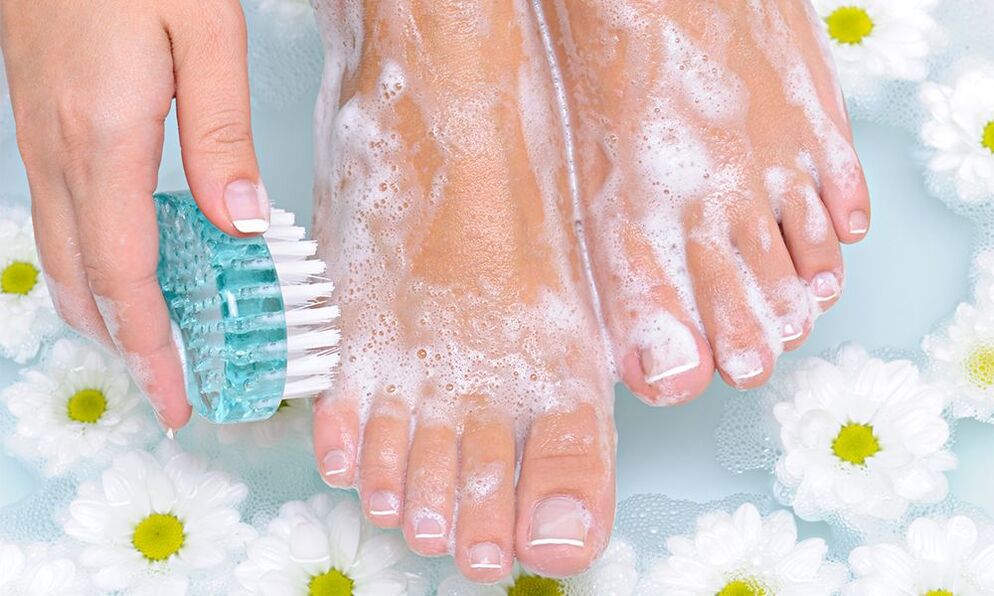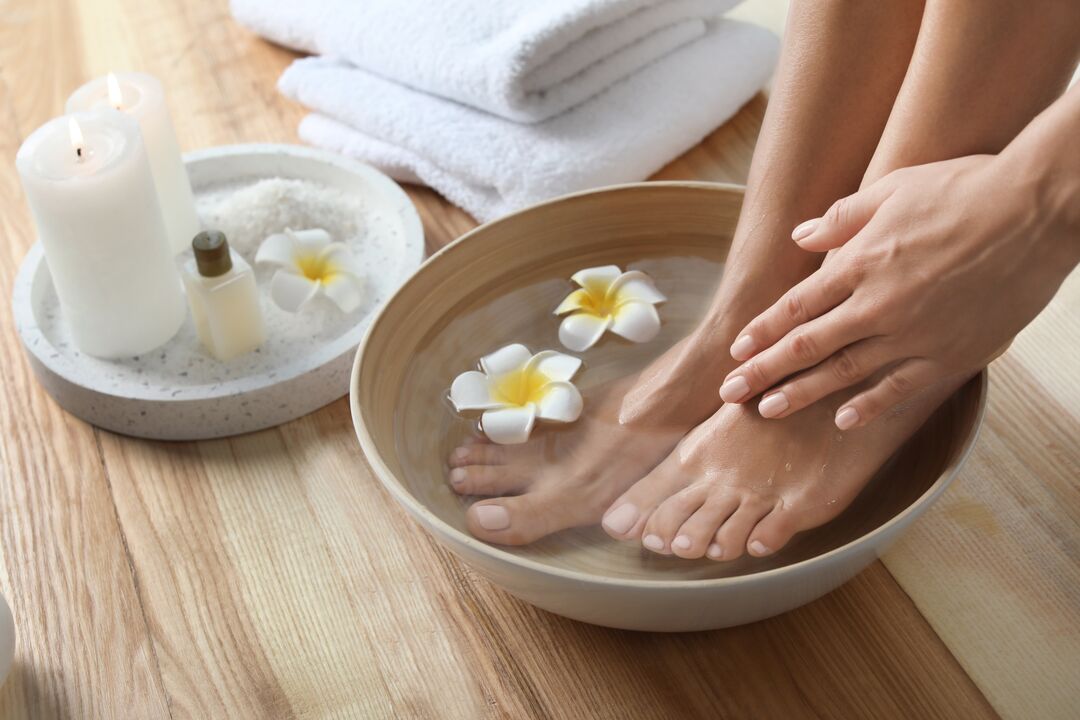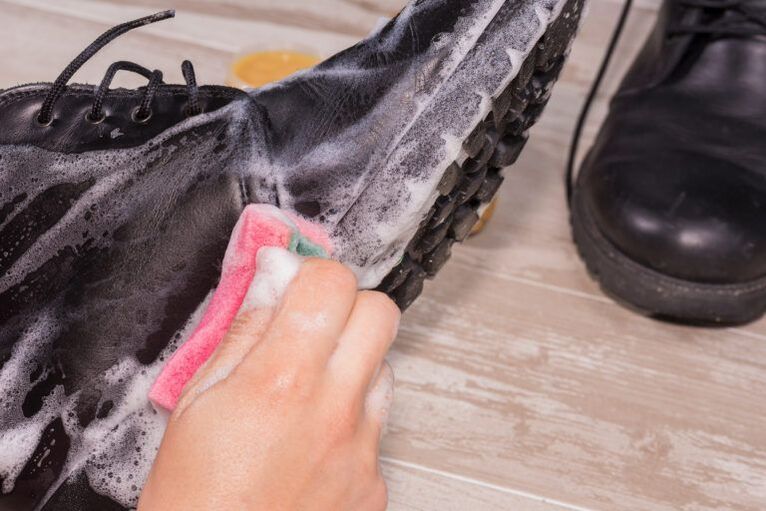Fungal infections in the body are always an unpleasant event. Medicines and folk methods help to eliminate it! Some time ago, vinegar began to be used for this purpose. It has a clear antiseptic effect and paralyzes the activity of parasitic microorganisms for a short time.
How does vinegar affect mycosis?

When treating nail fungus with vinegar, it is most often taken in a low concentration (9%). You can also take apple essence for these purposes. For severe fungal infections of the nail plates, even the appropriate essence is used.
Nail fungus does not like an acidic environment.Therefore, vinegar is effective against fungi because its environment is acidic. Regular use of the corresponding acid for medicinal purposes stops the reproduction of fungal microorganisms and causes their death. The key to successful treatment is the presence of the following properties in the table product:
- fungistatic;
- antiseptic;
- disinfectants;
- antimicrobial.
Treatment of nail fungus with apple cider vinegar should be a course of treatment, otherwise the disease may return. In this case, it is recommended to visit a dermatologist at the same time and use additional drugs prescribed by him. This treatment will give a more effective result.
Which vinegar is effective against nail fungus?
Vinegar for fungus should be used carefully, strictly following the recipe for preparing homemade medicine. You should be especially careful with the essence as it can cause chemical burns on the skin.
For onychomycosis, it is allowed to use any form of table vinegar with a concentration of not more than 9%. If you have a higher concentration of acid on hand, it must first be diluted with water.
Treatment of nail fungus with vinegar will be effective if the recipe for preparing the medicine used is followed correctly. It is advisable to use the described folk remedies in the early stages of damage to the nail plates, because in this case recovery will occur earlier.
Nail preparation
Treatment of toenail fungus with folk remedies should be done after preliminary preparation. This will allow the drug to penetrate more effectively inside and neutralize even deep-lying fungal threads. Preparing nails for the procedure consists of the following steps:

Washing the affected areas
Use soap or another detergent to thoroughly wash infected nails. It is recommended to clean each nail in turn with a special brush, which will help remove dirt particles from under the nail plates.
Evaporation
Clean nails should be placed in hot water (as much as the skin can tolerate) for 20 minutes. This will soften the layers of the epithelium and increase the permeability of the skin and nail to the applied product. You can add a small amount of hydrogen peroxide to the water, which will primarily neutralize the fungal spores on the surface of the nail plate.
Removal of infected areas
Using sharp scissors and a nail file, you should get rid of the infected parts of the nail, which can be peeled off painlessly. If the fungus has spread from the nail to the epithelium, it is necessary to remove the rough layer of skin from the feet.
After the preparation described, you can start the actual treatment! If there are no allergic reactions to the body composition, vinegar-based remedies should be used to treat this disease. Otherwise, you can seriously damage your skin by causing irritation.
How to treat nail fungus with vinegar?
Using vinegar for toenail fungus should be done first after consulting a dermatologist. This will help prevent dangerous and unpleasant consequences for the body. Today, many effective ways to use this folk remedy in the fight against foot fungus have been created. When using any of them, it is recommended to observe the standards of personal hygiene, as well as the recipe for preparing "home-made medicines".
There should be a course of treatment with vinegar, because the described infection is characterized by deep penetration into the nail. If the procedures are not carried out regularly, fungal spores can occupy the areas of the nail plate that are freed from them in a short time, which will cause the pathology to progress again.

Vinegar baths are effective against nail fungus. Dissolve a glass of apple product in a liter of hot water and immerse the affected parts of the body in the resulting solution. The procedure should be carried out for no more than 20 minutes, after which the feet should be rinsed with warm, clean water and wiped dry. After such evaporation, the medicine prescribed by the doctor can be applied to the bottom of the nail, which will increase the rate of penetration of the medicine into the source of infection.
Foot baths with vinegar can cause a slight burning sensation on the skin. This is the body's normal response to an acidic environment. You have to be patient for a while, then the skin will get used to the acid used. Treatment of fungus with vinegar should be done on clean nail plates, where there is no varnish or other decorative means. It is also not recommended to cover your nails with varnish for a few days after this procedure.
For nail fungus, acetic acid can be used as a banal application to the affected areas. This method is effective in the early stages of infection development. It is recommended to lubricate the marigolds with a table product after first steaming them in hot water. Thus, vinegar has a more effective effect on fungi, which can be noticed after several procedures. When lubricating nail plates with acetic acid, it is recommended to avoid contact with healthy areas of nails and skin.
Glycerin and vinegar essence helps against nail fungus. In a separate container, mix essence (70%), glycerin and medical alcohol in a ratio of 1: 1: 1. Moisten a cotton pad with the resulting product and apply it for no more than 15 minutes. fungus on the nail plate. It is recommended to attach a cotton pad with an adhesive plaster and wear warm socks. By making such a compress every day for a week, you can significantly improve the condition of the parts of the body affected by the fungus.
Glycerin and vinegar for nail fungus can be used in another way: mix them in equal volumes (2 tablespoons each) and apply the resulting composition to previously steamed sick nails. Against nail fungus, glycerin and vinegar are effective when used in the form of polyethylene-enhanced compresses. It is better to do this at night for two weeks. When treating with vinegar and glycerin, it is important that the body is not allergic to these drugs, otherwise there is no question of any recovery.
An egg in vinegar is also effective against nail fungus. Pre-washed raw eggs are placed directly in the shell in a clean container so that they touch the walls of the shell. Add vinegar until completely covered and store in a dark cupboard for 3 days. After the required time, the shell will be dissolved in acid, and the contents of the egg are mixed with the resulting solution. Add a little softened butter to the resulting mass until a creamy consistency is obtained. The prepared ointment should be rubbed on the nails with a fungus every day, and everything should be wrapped in cling film from above. Keep the described compress for no more than 8 hours. Treatment should be continued until the lesion disappears.

Vinegar and baking soda can help with toenail fungus when used in a bath. To do this, add 3% hydrogen peroxide (50 ml), baking soda (100 g), table vinegar (50 ml) and table salt (100 g) to a liter of hot water. Mix everything well in water and soak your feet for 15 minutes. The described treatment should be carried out twice a day during the entire calendar month.
Application at initial and advanced stages
In the early stages of the disease, nail fungus is easier to treat with vinegar. Regular removal of nail plates helps with it.
When the disease progresses to more severe forms and the nail begins to collapse, you should resort to the use of special drugs in addition to vinegar. In such situations, it is allowed to wipe even blackened nails with vinegar essence without penetrating healthy areas of the skin.
Use as a prophylactic
Even skin and nail damage can be prevented with the help of vinegar. For this, it is recommended to treat shoes and socks with the described product. Also, for preventive purposes, wet cleaning of rooms and furniture is carried out with vinegar solution. At the same time, a glass of vinegar product is poured into a ten-liter bucket of warm water and wet cleaning is carried out with a sponge soaked in it.
A previously performed foot bath with vinegar for fungus can be a source of infection for healthy households. Therefore, it is recommended to treat the container, tub and walls used for preventive purposes with antifungal compounds. This can be done with apple cider vinegar and soda, mix them in equal amounts and add hot water to them.
Treatment of shoes with vinegar

Vinegar should also be used to disinfect shoes when treating athlete's foot. In this case you need:
- wash your shoes with detergent and dry well;
- treat the inner surface of the shoe with a cotton pad soaked in acetic acid;
- dry your shoes.
Vinegar also helps against toenail fungus when used on shoes. This should be done every day until the disease is completely gone. In addition to shoes, it is recommended to soak for 30 minutes. hosiery of a suitable nature. Then it is recommended to rinse them well.
Use in children, pregnant and lactating women
Antifungal vinegar foot baths are not recommended for all categories of citizens. Thus, this drug is contraindicated for the treatment of children under ten years of age. The reason for this is the high sensitivity of the skin to the acidic environment.
Also, the described product is not recommended to be used for medicinal purposes by expectant and nursing mothers. Hormonal changes in the body of pregnant women cause their skin to become more sensitive to any aggressors, which may be an acidic environment.
Contraindications and side effects
Treatment of athlete's foot with vinegar is contraindicated for people suffering from individual intolerance to this remedy. It can be detected by simply applying acid to the skin.
It is necessary to stop using the product if the following are observed during application:
- skin itching;
- swelling;
- burning
In such a situation, safer alternative treatments should be preferred.
If there are lesions and wounds on the skin, it is not recommended not to be treated with this folk remedy. Acid components can increase the irritation that occurs, which can aggravate existing inflammation in the body. As a result, regeneration processes in the epithelium are significantly delayed.
If the fungus develops on the body, it should not be treated with the described product:
- eczema;
- psoriasis;
- other dermatological diseases.
Side effects of using the described product include burning sensation, skin irritation and even hyperemia. Burns may occur when using large amounts of essence. To protect your own body from such dangerous manifestations, it is recommended to carry out medical procedures with a high degree of caution.
Treatment of the fungus with folk remedies gives a positive result, but it takes a long course. It is advisable to start the procedures from the first signs of pathology, because in the future it will help to quickly rid the body of the disease and return the fingers to their former beauty.
















